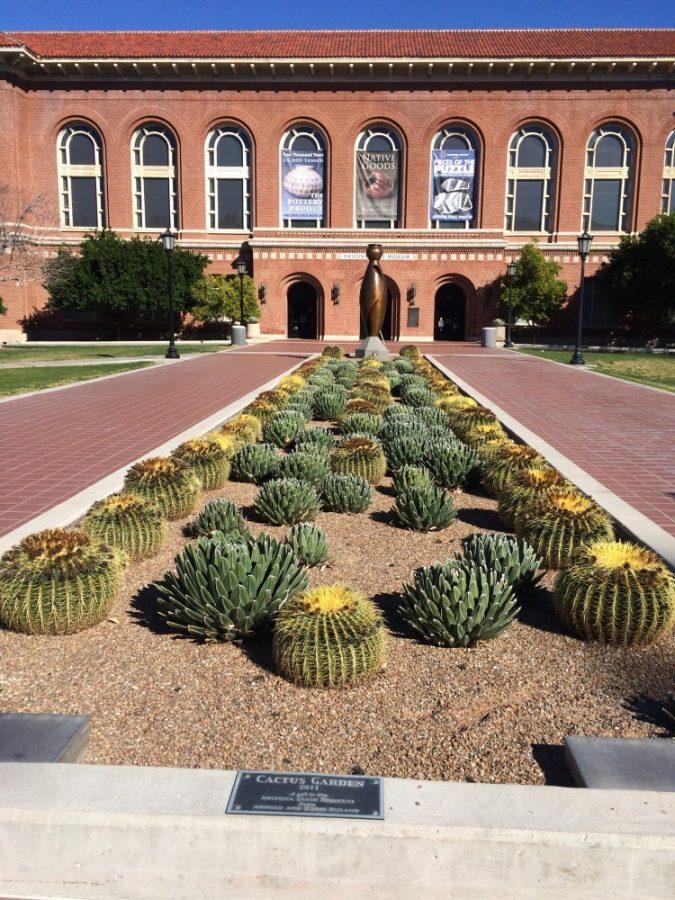College isn’t just for classes anymore. If you’re ready to weave your way through the coffee-clutching college students, you can find some really exciting and unique places on the University of Arizona campus. Scattered from the west end of campus to the east are different types of museums, from a planetarium to a state history museum. For a small admission fee, or sometimes for free, visitors can see one-of-a-kind artifacts or learn more about the history of photography, the state of Arizona or even the solar system.
Arizona State Museum – More than a collection of exhibits
From pottery to paintings, the Arizona State Museum is the place to visit for a comprehensive look at Arizona’s history.
“We have the world’s largest and most comprehensive collection of Southwest Indian pottery,” said Darlene Lizarraga, director of marketing. “We have over 24,000 complete vessels.”
The museum also has more than 35,000 specimens of American Indian basketry, and is working on opening an exhibit to showcase these baskets.
The museum is much more than a collection of exhibits. Scholars have been conducting research and preserving these artifacts for future generations since the museum’s founding in 1893. It is the largest and oldest anthropology museum in the Southwest, and will be celebrating its 125th anniversary next year. The Arizona State Museum is the state’s archaeological repository, and its collection grows on a daily basis, according to Lizarraga.
Admission to the museum is $5 for adults, and it is free for children under 17 and University of Arizona students, faculty or staff with a CatCard. It is open Monday through Saturday, from 10 a.m. to 5 p.m.

Center for Creative Photography – Capturing the human experience one photo at a time
Walking into the Center for Creative Photography is like entering a secret hideaway. The gallery is silent. You can hear every breath you take and the sound of your shoes on the floor feels as loud as the planes overhead.
The museum currently has an exhibit on still life photography called “Flowers, Fruit, Books, Bones,” and another exhibit of self-published photo books selected by a jury of professionals. The books are displayed on shelves and tables where visitors can flip through any of them.
Like the Arizona State Museum, the CCP has a non-public side.
“It is both a museum and an archive,” said Steve Llewellyn, assistant director of facilities management and planning. “Most museums display just finished products, but this museum has the background information too.”
The center also collects objects from the exhibited photographers’ lives, such as letters or negatives, to display along with the actual photos.
Visiting the Center for Creative Photography is free to the public, but donations are accepted. The center is open Tuesday through Friday from 9 a.m. to 4 p.m. and on Saturday from 1-4 p.m. It is closed Sunday and Monday.

Flandrau Science Center and Planetarium – Take a trip that’s out of this world
Ever want to go to space? Head to Flandrau Science Center and Planetarium. You can see all sorts of space related objects without ever leaving the comfort of your own atmosphere. You can see a scale model of the planet sizes relative to the sun, see the original moon model from the Space Race in the 1960s and walk through a model of the inside of an asteroid. Below the main planetarium area is the mineral museum, full of different types of gems and minerals.
Facts and information are mixed in with hands-on activities to make learning fun.
“The hands on exhibits engage kids and families the most,” said Shipherd Reed, associate director of communication.
While learning about the atmosphere, visitors can shape sand into mountains and valleys to see how it would affect the watershed. There’s a whole section of math games and a craft station where kids can fold paper into different three-dimensional shapes.
The planetarium was opened in 1975 after a gift from writer Grace Flandrau made it possible. It has just finished renovations to upgrade the projector in the theater with full-dome digital projection.
“It [the museum] offers something unique,” Reed said. “It’s fun and entertaining and at the same time you’re learning. You’ll enjoy your visit and walk away knowing more about the world you live in.”
Admission to the planetarium is $14 for adults and $10 for children, which includes access to the mineral museum, the planetarium and a show. If you’re interested in only a show or only the museums, it’s $7 either way for adults and $5 for children. College students get in for $10 with an ID.
Next time you’re out and about on campus, consider stopping by one of these museums.
Follow Taylor Brestel on Twitter















